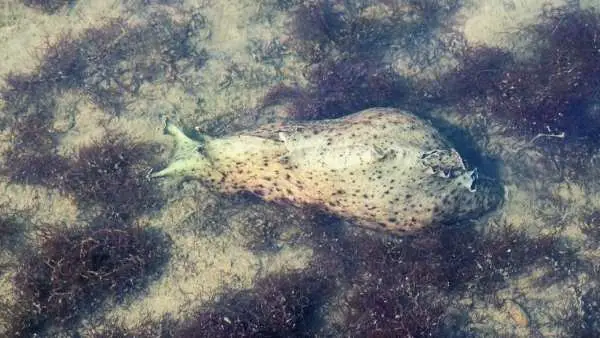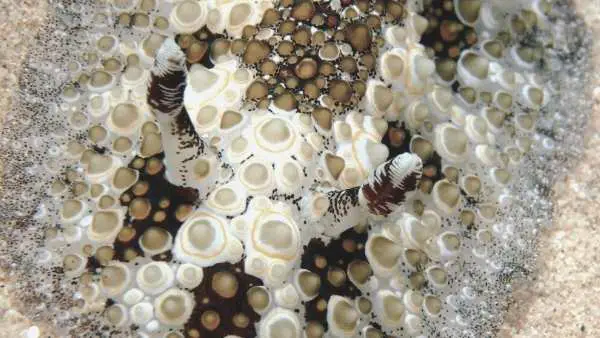Stomatella Varia is the scientific name given to these Critters. Before we dig in and explain the benefits and attributes that these snails bring to your aquarium, adding these snails into your aquarium is not a bad thing. In fact, it is recommended to introduce them to your community, and if you discover one residing in your tank randomly – there are plenty of good reasons to keep it in there!
Many people might freak out because they are snails, and let’s be honest, snails are not the most attractive critters you could be adding to your tank, much like an unexpected critter appearing in your tank – they are not the most aesthetically pleasing. So, this article is designed to identify whether or not you need a Stomatella Snail firstly, and also what to do if you discover one in your tank.
They are a snail species that takes up more of a slug form with only half a shell, with the shell only encompassing half of the snail’s body and half the snails head, with an oval shape, similar to a fingernail. These snails are not pests, far from it, and they will make a great addition to your tank’s clean-up crew, feeding primarily off algae – they will certainly help take out a lot of unneeded and bad algae that plagues your tank.

They are not big at all, so will not take up much space and be intrusive towards the rest of your tank community, only growing to around 1 inch (2.5 cm) in length. They also come in an abundance of different colors, so will certainly not look out of place in a colorful aquarium environment, coming in black, white, green, and brown, with even more exotic specimens taking up orange, pink, and red coloration.
Stomatella snails are totally reef safe and compatible, and unlike most clean-up critters, or unwanted creatures that occupy your tank, they do not tend to overbreed and will only populate in sensible numbers. So, if you are to discover or plan to add one of these in your tank, leave it in there and enjoy the work they will put into your tank to help keep it clean and mostly algae-free area, all for free!
So, now we have to discuss potential threats to these helpful snails, because unfortunately they can become a tasty treat for some of your community if you are not careful. Some fish and shrimp will eat, or at least attempt to eat the snails, and they should certainly be kept well clear of certain “critter eating” Wrasses, in particular the Six Line Wrasse and Four Line Wrasse. Also, if you have a Peppermint Shrimp in your tank, expect the snail to be eaten with relative ease.
Stomatella snail additional information and requirements
- The snails are reef safe.
- The water in your tank must have stable magnesium and calcium levels.
- The water must be stable and clean (cleaned regularly).
- Obviously, Algae is needed for these critters to eat, however, if your tank is rid of Algae then a good alternative is Nori, which is dried seaweed.
- They will not survive in a tank with a high nitrate level.
- The recommended tank size is around 20 Gallons (90 Liters) for between 1 to 5 snails.
- Feeding Habits and Other Food-Related Requirements
- The Stomatella Snails are herbivores.
- Their main source of food is Algae, they will also eat diatoms, cyano, macro, film, and hair algae.
- You can supplement their diet with nori, a dried seaweed.
- These snails have also been known to eat leftover flaked food.
Acclimatization
These critters will take a fairly long time to acclimate. The best option is to slowly drip acclimatize them slowly, and for around double the time you would to for a fish, between an hour and a half to two hours, just to be sure.
Once they have been acclimated, the best method for tank placement would be to add them to a stable rock work, instead of the tanks sand bed as they prefer to be on harder surfaces, like rocks.
Snails in general struggle with acclimatization, so the best thing to do is keep an eye on yours once you have introduced it to your tank, and if you do not see much movement or action being taken by the snail, you should place it somewhere else that you can keep a closer eye on, and if moving it to another spot doesn’t work, then you will probably just have to remove the snail from the tank all together.
Conclusion
In conclusion, despite the fact that they are a snail species, and may look like a typical tank pest that you need not bother with, the reality is that they will quickly become an incredibly important and brilliant member to any aquarium community. They mind their own business, are peaceful and slow by nature, and do one heck of a job at cleaning up your tank and making sure there is minimal algae, which certainly is one less thing to worry about.
One thing to watch out for is overbreeding, however, they tend not to do this. As all hobbyists know though, nothing is ever a guarantee with aquarium owning – just keep an eye on them and make sure they are not multiplying in numbers too rapidly.

Like most snails and other small critters, the Stomatella snail will become a meal if you are not careful with the communities you introduce them too. If there are some of the previously mentioned fish or shrimp in your tank, either make sure your tank is big enough to house them all or leave the snails until you can properly house them.
If you are looking to introduce these snails to your tank to join the natural clean-up crew, it is important you have the necessary experience and also an established enough tank for them to have enough food, and not get eaten. Also, if they do not acclimatize properly after a few attempts, then you probably should stop trying and attempt it again in the future.

